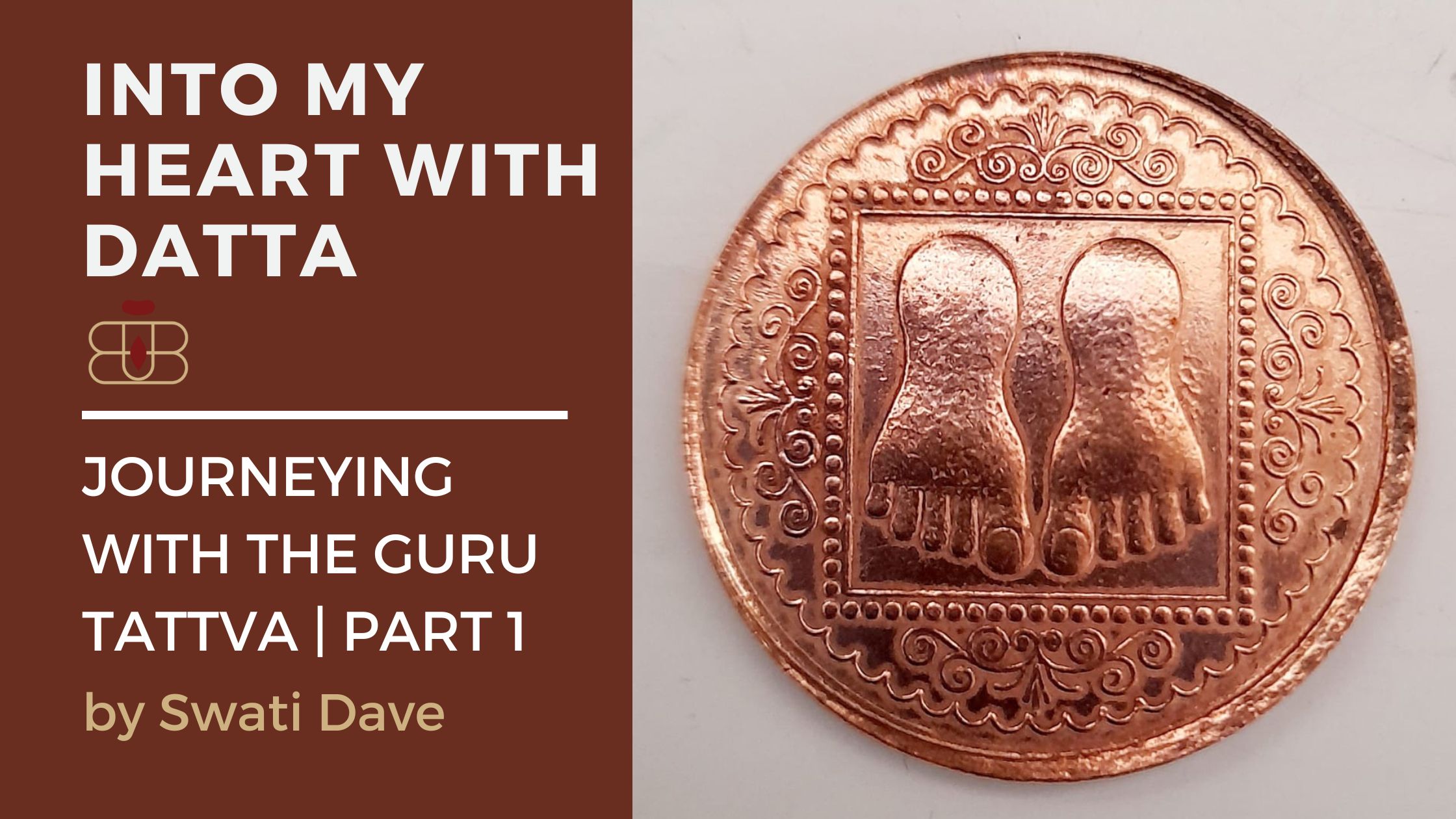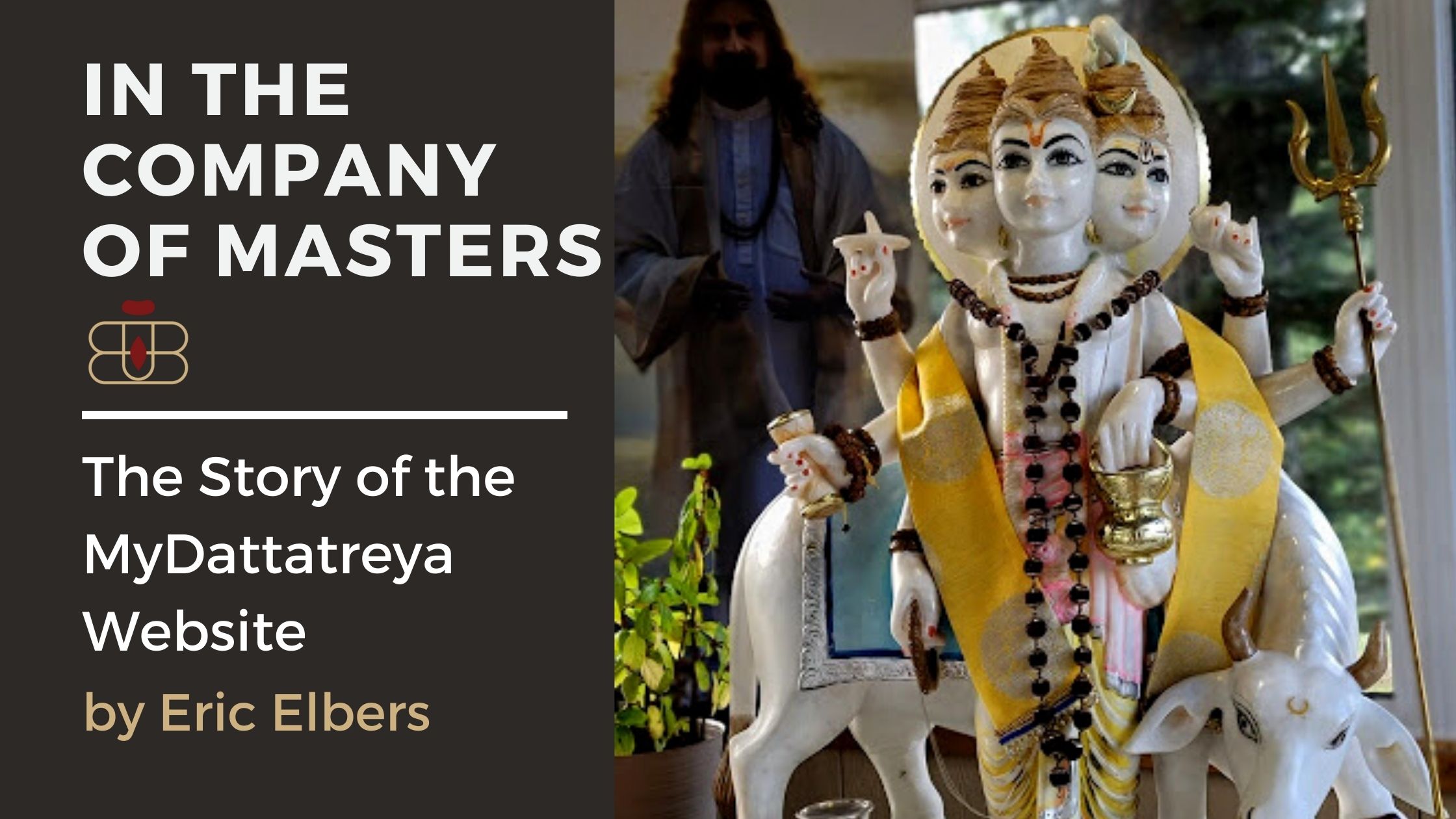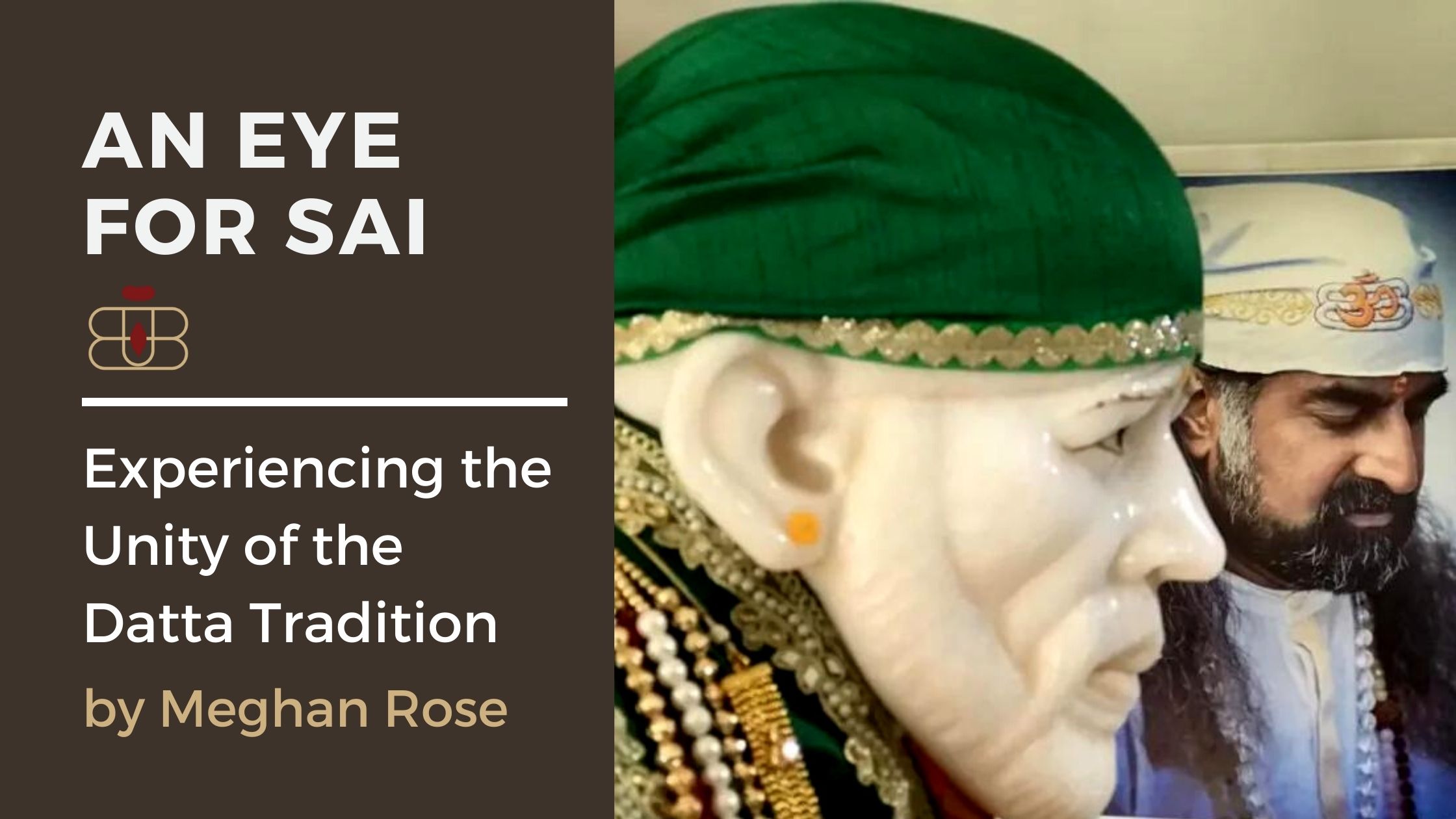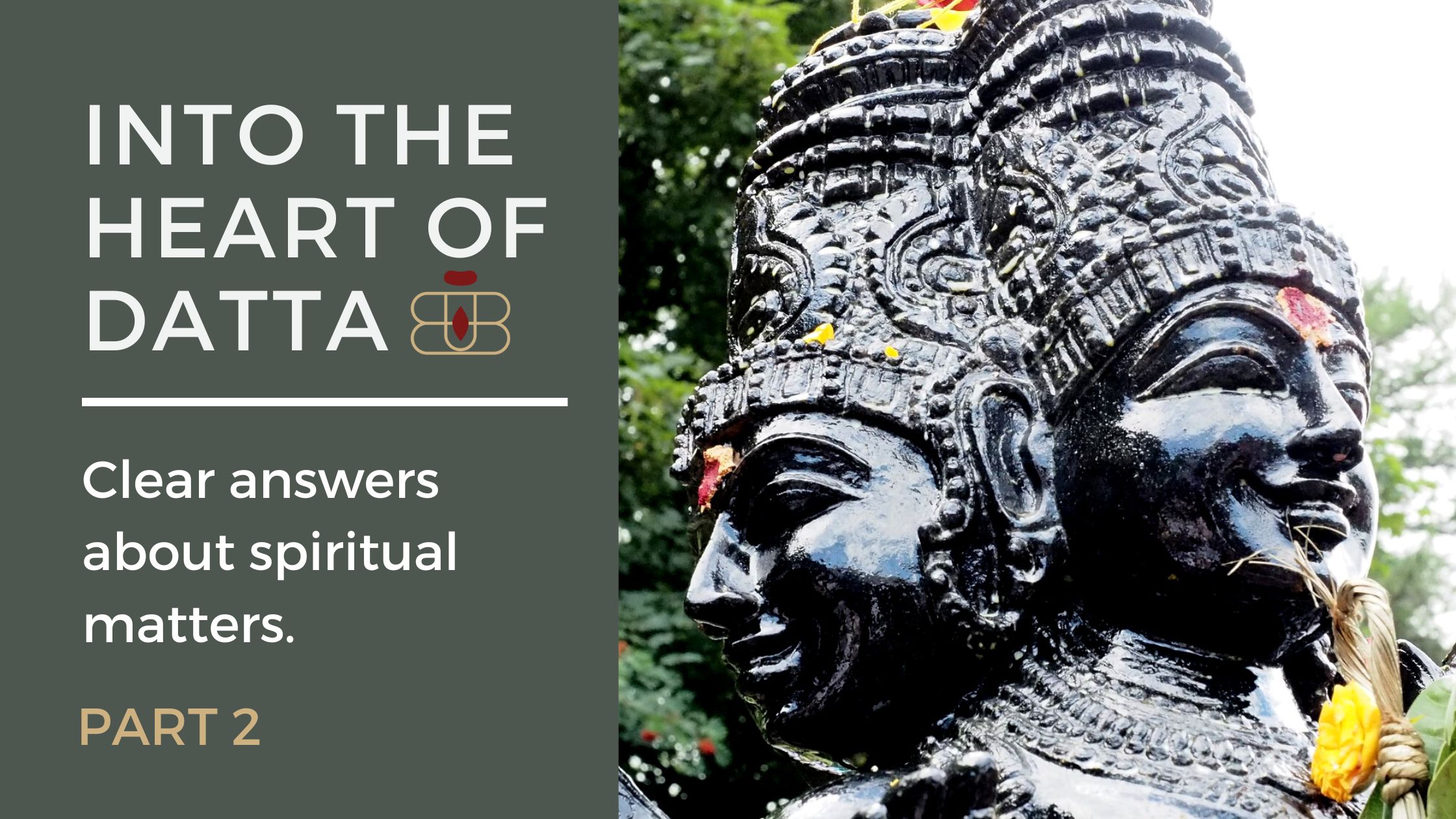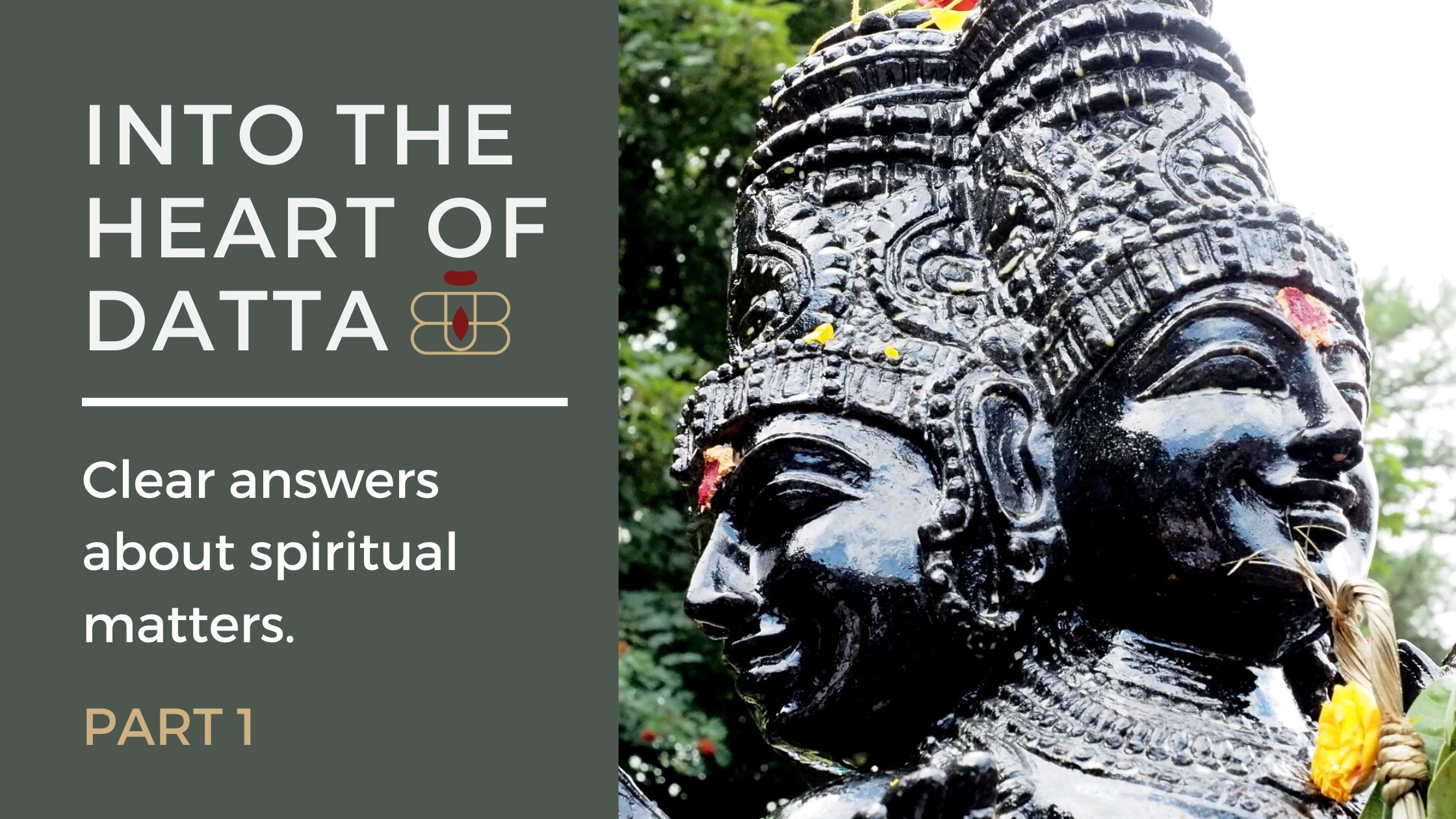Overview and Significance
Exploring Kauai’s Hindu Monastery, you will hear about Satguru Shiva Subramuniyaswami, lovingly called Gurudeva, the brilliant soul who established this sanctuary and enriched uncounted lives. He was a shining example of awakening and wisdom, recognised worldwide as one of Hinduism’s foremost Masters. His prodigious genius, flair, and inspiration permeate this spiritual oasis and continue to guide the lives of those he trained and initiated. Gurudeva was born in California and grew up near Lake Tahoe. Orphaned at age 11, he was raised by a family friend who had spent years in India and brought him into Hinduism’s culture and beliefs. Trained in classical Eastern and Western dance and yoga disciplines, he became the premier danseur of the San Francisco Ballet at age 19.
At the height of his career, he renounced the world, and in 1947 he sailed to India in quest of his spiritual Master. In a remote Sri Lankan cave, he fasted and meditated until he burst into enlightenment. Soon after, he met Shiva Yogaswami, who gave him the name Subramuniya and initiated him into Hindu monasticism. From then on, the great truths flooded through him like a torrent. The nature of reality, metaphysical principles, and methods for facing life’s challenges were evident to him. What philosophers struggle to explain in complex theories, he articulated in simple language from his own experience. Ultimately, the cream of his inspired talks became the 3,000-page trilogy of Dancing, Living, and Merging with Shiva, the first cogent, comprehensive expression of monistic Shaiva Siddhanta in the English language. A powerful purpose drove his every effort like the rhythm of a vigorous dance. He traveled widely to uplift Hindu communities on every continent, represented his religion at global conferences, and helped establish 37 temples worldwide.
An extraordinary mystic, Gurudeva had many visions of the Deities. He read clairvoyantly from inner-plane scriptures and created his own language, Shum, to map for others the profound states he encountered in meditation. Gurudeva was loved by all who met him—Hindus, leaders of all lineages, island neighbors, and ordinary folks. He saw the Divine in every person and taught them to see the Divine in themselves. To devotees everywhere, the graceful, six-foot-two, white-haired Guru was the embodiment of Lord Shiva Himself. Gurudeva continues to guide, in magical ways, all who embrace his teachings from the inner world. His light lives on in their spirit and their striving for Truth.
Life History
Youth in California (1927–1946)
Shivaya Subramuniyaswami was born in California in 1927 as Robert Hansen. He is quoted as relating how at the age of six, the totality of the power of the eternity of the moment began to become stronger and stronger from that time onward. He was most inspired by the life of Swami Vivekananda and his four small volumes: Raja Yoga, Bhakti Yoga, Karma Yoga, and Inspired Talks, and most notably by Swami Vivekananda’s masterful poem, ‘The Song of the Sannyasin’.
Shivaya Subramuniyaswami’s training in classical Eastern and Western dance and the disciplines of yoga developed him into a dancer. He joined the San Francisco Ballet Company, becoming their danseur by age nineteen. At twenty years of age, he took the first ship to leave for India after World War II. He celebrated his twenty-first birthday just days before going ashore and walking through the grand Gateway to India in Mumbai.
Visit to Sri Lanka (1947–1949)
Shivaya Subramuniyaswami spent almost three years on the island of Ceylon, now called Sri Lanka. Before meeting his guru, he studied with his fourth “catalyst” for a year and a half. Shivaya Subramuniyaswami just wanted to meditate, but his teacher made him work to help village people reconstruct rural areas. Shivaya Subramuniyaswami visited and lived in many Buddhist temples in Sri Lanka. He was received by the monks there and saw how they lived and dressed. This experience influenced the monastic protocols that he later put into action in his monastic order in a very strict way.
In the caves of Jalani, Kurugala Balandha, Sri Lanka, he fasted and meditated until he experienced what he felt to be enlightenment. Shivaya Subramuniyaswami relates his feelings while returning to Colombo, Sri Lanka: ‘Returning back to the city, nothing looked the same anymore. I was in another dimension. Everything was different. I had lost something: the desire for the realisation of the Self. I felt complete. I felt alone.’

Gurudeva in 1949, right after his return from Sri Lanka.
Back in Colombo, Shivaya Subramuniyaswami met his final teacher before meeting his Guru. One day, his teacher arranged a meeting between Shivaya Subramuniyaswami and his long-awaited Satguru, Sage Yogaswami. After a deep and inner meeting, Yogaswami gave him the name Subramuniya, an epithet of Sri Murugan. Subra means ‘the light that emanates out from the central source’. Muni means a silent teacher, and ya means restraint. Subramuniya means a self-restrained soul who remains silent or speaks out from intuition. After a few visits, Jnanaguru Yogaswami initiated Subramuniya into sannyasa and ordained him into his lineage with a slap on the back, giving the following instructions: ‘This sound will be heard in America! Now go around the world and roar like a lion. You will build palaces (temples) and feed thousands.’ This event was witnessed by several Jaffna area devotees, notably a local magistrate named Thiru S. Subramaniam.
Yogaswami continued to communicate with Shivaya Subramuniyaswami through Kandiah Chettiar until he died in 1964. In the line of successorship, Subramuniya was considered the 162nd Jagadacharya of the Nandinatha Sampradaya’s Kailasa Parampara.
San Francisco (1949–1970)
In late 1949 Subramuniya sailed back to America and embarked on seven years of ardent, solitary yoga and meditation. In 1956, Shivaya Subramuniyaswami said he had a tremendous spiritual experience in Denver, Colorado, where ‘the soul body would finally fully inhabit the physical body.’ In San Francisco, Subramuniya founded the Himalayan Academy and opened America’s first Hindu temple at 3575 Sacramento Street, near Presidio Park. In Switzerland, 1968, he wrote of Shum, a mystical language of meditation that names and maps inner areas of consciousness.

Kadavul Temple at Kauai’s Hindu Monastery
Between 1950 and 1957, Subramuniya spent much of his time exploring various non-traditional religions. He traveled around the United States studying Christian Science, Theosophy, the Science of Mind, the Self-Realisation Fellowship, Unity, Religious Science, and Spiritualism. His shift to a teaching ministry as Master Subramuniya in 1957 blends these religious movements with Hindu yogic and Vedanta teachings in a language oriented to Westerners. Subramuniya in the 1950s and 1960s might be placed in an American metaphysical lineage that can be traced from nineteenth-century Theosophy to the New Age Movement in the late 1970s. Subramuniya’s early publications, The Self-God (1959), Cognizantibility (1958), Gems of Cognition (1958), and the Clear White Light (1968), make no mention of Shaiva Siddhanta, the term ‘Hinduism’, or Shiva. They provide no biographical details on Subramuniya, nor do they mention his Guru or lineage. All of Subramuniya’s early works stress meditation, an Advaita-based monism, and yoga, but make no mention of Subramuniya’s Hindu religion or sectarian affiliations or his avocation of temple worship prominently found in his later works.
While Subramuniya blended Aquarian teachings with Hinduism in one context during the 1950s and 1960s, he also combined aspects of Hinduism with Christianity in another context. Subramuniya opened two centers in San Francisco in 1957: one nominally Hindu, the Subramuniya Yoga Order, and the other, the Christian Yoga Church. A typical Sunday worship at the Christian Yoga Church included singing Christian hymns, readings from the New Testament and the Bhagavad Gita or Upanishads, and a sermon related to Christian or Hindu mysticism. In this context, Master Subramuniya was known as Father Subramuniya.
Kauai (1970–2001)
In Sri Lanka, Shivaya Subramuniyaswami formally took possession of the main building of his Sri Subramuniya Ashram in Alaveddy, founded in 1949. Shivaya Subramuniyaswami moved his ashram to Kauai in 1970, establishing Kauai Aadheenam (Hindu Monastery) on a riverbank near the foot of an extinct volcano. Also known as Kauai’s Hindu Monastery, Kauai Aadheenam is a 458-acre (185 hectare) temple-monastery complex on Hawaii’s Garden Island. In 1979 he published the Holy Orders of Sannyas, defining Hindu monasticism’s ideals, vows, and aspirations. In 1979 he founded the Hinduism Today magazine. In the early 80s, after his world tours, he focused his magazine on uniting all Hindus, regardless of nationality or sect, and inspiring and educating seekers everywhere.
In 1986 Shivaya Subramuniyaswami founded a branch monastery in Mauritius in response to the government’s request that he come there ‘to revive a languishing Hindu faith.’ In 1991 he produced the Nandinatha Sutras, 365 aphorisms that outline the path of virtuous Hindu living. Especially in the early 1990s, he campaigned for fair treatment of temple priests, mainly that they should receive the same respect enjoyed by the clergy of other religions. In 2000 he published How to Become a Hindu, showing the way for seekers to formally enter the faith, disproving the notion that ‘You must be born a Hindu to be a Hindu.’ In November of that year, he launched Hindu Press International (HPI), a free daily news summary for breaking news sent via e-mail and posted on the web. In 2001, he completed the 3,000-page Master Course trilogy of Dancing with Shiva, Living with Shiva, and Merging with Shiva – volumes of daily lessons on Hindu philosophy, culture, and yoga. On November 12, 2001, he died surrounded by his monastics and devotees.
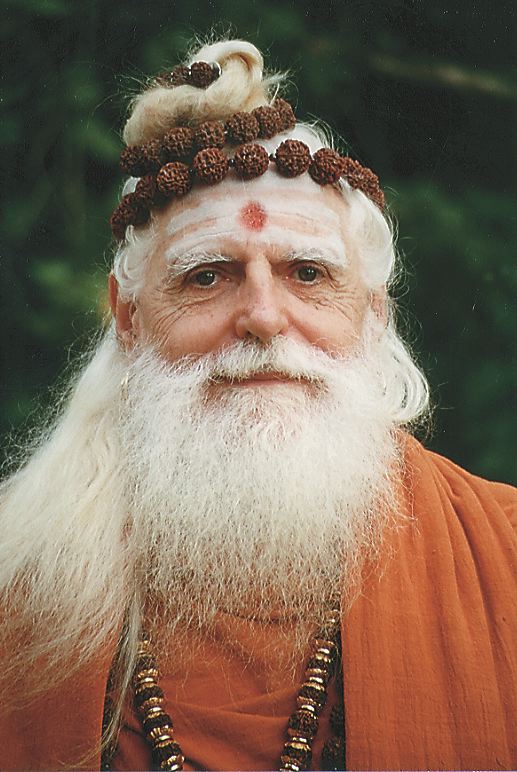
Tradition and Gurus
‘As Satguru, I am in exclusive intimate spiritual communion with each of my devotees. I am at the center of each seeker’s life, beating in each heart, aware in each thought, good, bad, or indifferent. I keep the threads of every devotee’s karma. I am the spiritual voice of dharma in their lives. To those seeking to understand our subtle tradition, it must be openly stated that the Satguru is the keeper of all the intertwined threads, the repository of all intimate knowledge, the knower of the continuities of all his followers’ karmas and dharmas, the confidant of each one’s secret heart, the listener to their most painful confessions in sealed confidentiality, the giver of their mind-quieting penances, or prayaschittas, the interpreter of their transcendental, light-filled breakthroughs, visions, and dreams, the guardian of the future of each sishya.’
So said Satguru Shivaya Subramuniyaswami in the 1995 edition of Shaiva Dharma Sastras, The Book of Discipline of Shaiva Siddhanta Church.
The most recent four Gurus of the Nandinatha Sampradaya’s Kailasa Parampara, Gurudeva’s spiritual lineage, met their preceptors at the famed Nallur Kanthaswamy Temple to Lord Muruga in northern Sri Lanka.
Around 1860, Chellappaswami (1840–1915) first saw Kadaitswami (ca 1810–1875) at this sacred shrine. Forty years later, about the year 1900, Yogaswami (1872–1964) encountered Chellappaswami at the Nallur chariot shed. The sage called out to him, ‘Hey, who are you?’ Yogaswami was transfixed by the inner meaning of that question and the power of his questioner. In 1949, on his way to meet Yogaswami, Gurudeva had a vision of the 77-year-old sage inside Nallur Temple’s inner sanctum during puja. An hour later, when they met in person, Yogaswami asked him, ‘Did you see me?” Gurudeva answered, “Yes. I saw you at Nallur.’
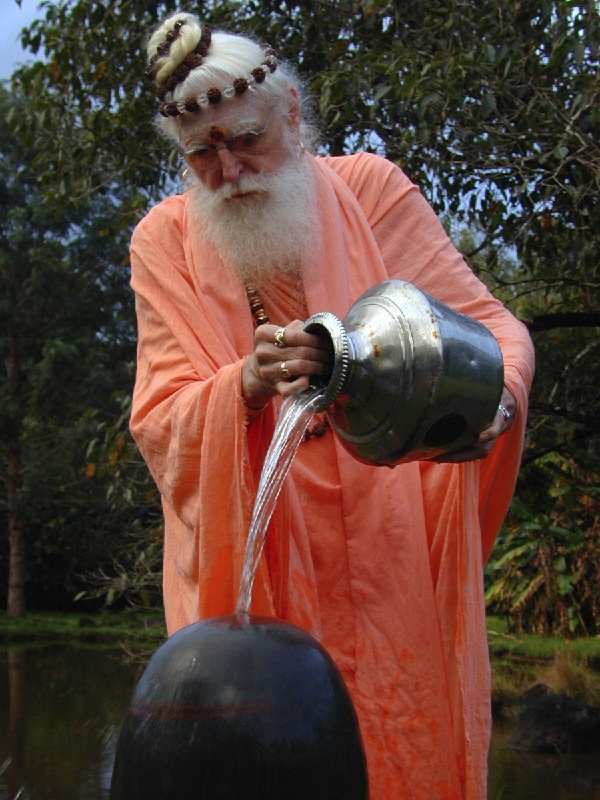
Teachings
On the Path to Perfection
Excerpts from the mystical masterpiece ‘Merging with Shiva’:
~ Hold your center. Find the place within you that has never, ever changed, that’s been the same for many lives, that feeling that has been the same within you since you were a little child up to this very time. Find that! Catch that vibration, and you’ve caught the vibration of the soul.
~ Man knows where he is in the mind, but the first step in awakening on the path of enlightenment is to separate awareness from that which it is aware of.
~ Man’s individual awareness is like a ball of light, and it’s like a camera. It photographs. It registers. It understands. It is pure intelligence.
~ There have been many systems and principles of ethics and morality established by various world teachers down through the ages. All of these have had only one common goal—to provide for man living on the planet Earth a guidepost for his thought and action so that his consciousness, his awareness, may evolve to the realisation of life’s highest goals and purposes. The ancient yoga systems provided a few simple yamas and niyamas for religious observance, defining how all people should live.
~ Unfoldment doesn’t take a lot of time. It just takes a lot of willpower. Someone can go along and sit at attention, concentrate and meditate for years and years and years, and, with a minimal amount of willpower, constantly be distracted, always complaining, and continuously unsuccessful.
~ Everyone is prepared to die. Whether it happens suddenly or slowly, intuitively, each individual knows exactly what he is about to experience. Death, like birth, has been repeated so many times that it is no mystery to the soul.
~ Learn to concentrate the mind so that you can study not from books but from observation, which is the first awakening of the soul. Learn to study by practice. Learn to study by application. Become a student of life and live life fully, and as you merge into the sea of actinic life, you will realise that you are not your mind, body, or emotions. You will realise that you are the complete master of your mind, body, and emotions.
On Monistic Theism (Source: Living with Shiva)
There have been for a thousand years or more two major streams of thought in India’s spiritual traditions, one called Advaita in Sanskrit, or monism in English, Monistic Theism, and the other called Dvaita or theism. Our own tradition, known by many names—monistic theism, Advaita Siddhanta, monistic Iaiva Siddhanta or Advaita Eßvaravada—embraces them both fully. I discovered that the path of monism and theism is the whole of life. As my Satguru explained, it is the entire path. He compared it to an orchestra and an audience. Playing in an orchestra and being in the audience are two different experiences. The audience without the orchestra is not complete. They would be just sitting hearing nothing. The orchestra without the audience is not complete. They would be entertaining no one. So it is in the plane of duality. We have to practice duality intelligently.
Satguru Yogaswami had the full advaitic realisation of the Self, ParaShiva, but at the same time, he had the fullness of dvaitic devotion toward God, the Gods and his Guru. By the example of his own life, Satguru Yogaswami showed that, having reached the top through realisation, the seer cannot reject any part of the mountain because he remembers his experiences at the bottom, his experiences in the middle, and his experiences at the top. Yogaswami taught that we cannot reject direct experience. No one can take that away from us. Therefore, realisation is not synonymous with the word understanding. It is recorded in the akaßa forever.
When a musician is playing an instrument in an orchestra, he has the experience of moving his fingers, arms, and hands. The musician is hearing what he is playing and what everyone else is playing as well. Each player realises the unity of the entire orchestra. This is the experience of monism—that wonderful oneness. A member of the audience listening to the orchestra is not hearing just one instrument, but all are playing together in unison. But he is only experiencing through his ears. That is the experience of theism—that wonderful twoness.
The orchestra can exist without the audience, but the audience cannot exist without the orchestra. That is why the monist can go on with his practices even if there is no temple close by to worship in. He can go on with his practices even without an image of God. The theist cannot do this. Without the image of God or a temple to worship within, he is lost.
Monistic theists are practical philosophers. They put the orchestra and the audience together. They have the grand experience of the fullness of life. They enjoy the top of the mountain and its bottom. They put monism into theism and bring theism into monism. They are the total persons on this planet. All the great yogîs and sages wandered from temple to temple worshiping externally, and in their internal worship realised God and the Gods within themselves.
Quotes and Quips
~ You are not your mind because you can control your mind with your will.
~ Man is not man; man is God.
~ There are only two things you can depend on: one is the changeableness of life, and the other is the unchanging Self within you.
~ As your mind releases its desires and cravings; it releases the hold that it has on you. You dive deeper, fearlessly into this blazing avalanche of light, losing your consciousness. And as you come back into the mind, you see the mind for what it is, and you are free. You find that you are no longer attached because you see that the binder and the bound are one. You become the path. You become the way. You are the light.
~ You have to want the Self more than your life because that’s what it is—more than your life.
~ The world is divided into two kinds of people: the wise and the otherwise.
~ To know the Self God, go into the that of that, then into the that of that, further into the that of That.
~ Everything is permanent until it changes.
~ God Shiva is Immanent Love and Transcendent Reality.
~ I’ve always been a supporter of mind over matter. If you don’t mind, it doesn’t matter.
~ Anava, or ego, could seem like spirituality, but in reality, it’s only spirit-duality.
~ The pilgrimage toward any experience starts with your first concept of it.
~ For creative things, give time. For productive things, give goals.
~ Only when man realises the Self does he attain his full maturity and find completeness.
~ Mystics walk away from an uncompromising situation. They don’t stick around to make more karmas in this life.
~ The whole idea of being adharmic to preserve dharma makes humans the most despicable creatures. This should be ripped out of Hinduism without mercy as far as I am concerned.
~ A spiritual man always has to have the upper hand on the lower nature.
~ There is no true path that leads away from religion.
~ At this time in the Kali Yuga, ignorance is equally distributed worldwide, and wisdom has become an endangered species.
~ When you react to a situation, do not reenact it. Wait until the emotional nature has completely composed itself, then study your reaction.
~ If you are going to control your income, start by controlling your emotions.
~ No man is my enemy. No man is my friend. All men are my teachers. Some teach me what to do; some teach me what not to do.
~ Be happy with your achievements, which are done with willpower. That will help accomplish your goals and, further, give you the confidence to carry out more tasks.
~ If anything goes wrong within a marriage, the blame should be on the man. He’s the head of the house and should be responsible for ensuring everything goes right.
~ Consistency is the key to the conquest of karma.
~ Money is cold, so you need to be cool, too, when you deal with it.
~ The whole path is a total surrendering. All four sects of Hinduism meet in surrender, prapatti, to the Divine.
~ Time is the curvature that makes all people the center of the universe.
~ The mystery is no mystery to the mystic.
~ Intelligence is finite, but stupidity knows no limits.
~ Listen for silence in noisy places; feel at peace in the midst of disturbance; awaken joy when there is no reason.
~ If you want to know how much you have progressed in your spiritual life, just look back and reflect on the changes.
~ Even to hear about the Self is good and brings about good karma. Not many will be exposed to the Self.
~ Vindictiveness comes from insecurity.
~ It is a gift of God to see ourselves as others see us.
~ Sitting in a state of meditation, you must be more alive and alert than a tightrope walker suspended without a net on a taut cable.
~ Draw awareness inward, toward the center. When you are elsewhere, you are in one place. When you are the center, you are everyplace.
~ When looking for tax deductions stops, then true giving begins.
~ With all His wondrous powers, the one thing Shiva cannot do is take Himself out of you.
~ Shiva is the Life of our life.
Sacred Practices/Sadhana
(Source: Merging with Shiva)
Aum Nama Shivaya takes us into the reality above and beyond the relatively real. To know it is to experience it and to experience it is to become initiated. I have been performing Aum Nama Shivaya for over fifty years. At first, it had no meaning other than, ‘Wonderful, at last, I got my mantra and an assignment from my Guru to perform Japa regularly.’ As the Japa progressed, all the inner worlds opened, all the doors of the mind. All the spiritual forces were unleashed, and the ability to control them came naturally.
This most pragmatic mantra is found at the center of the Vedas, in the hymn known as Sri Rudram, and Shiva is at the center of Nama Shivaya Aum. You see, Nama Shivaya Aum brings the totality of the individual to the forefront and makes it manifest in daily life. As the center of the Vedas, it blends Vedanta with Siddhanta, fusing them together with the fire of realisation. So, I and all Shaiva Siddhantists are a fusion of Vedanta and Siddhanta, with all doors open of understanding the fourteen windows, the chakras of the mind, and even more than that.
My Satguru, Shiva Yogaswami, placed great emphasis on Japa, repeating the name of Iiva with concentration and feeling. This great Natha jnani explained, ‘May we not forget that mantra is life, that mantra is action, that mantra is love, and that the repetition of mantra, japa, bursts forth wisdom from within. Japa yoga is the first yoga to be performed toward the goal of jnana. In the temple perform japa. Under the sacred tree, perform japa. I performed japa all of this life as a silent sadhana, and it is automatic now.’ Shiva Yogaswami enjoined his devotees: ‘Wear rudraksha beads, repeat the Panchakshara, let your heart grow soft and melt. Chant the letters five, and in love, you will discover Iiva’s will. Chant so that impurities, anxieties, and doubts are destroyed. All hail Nama Shivaya.’
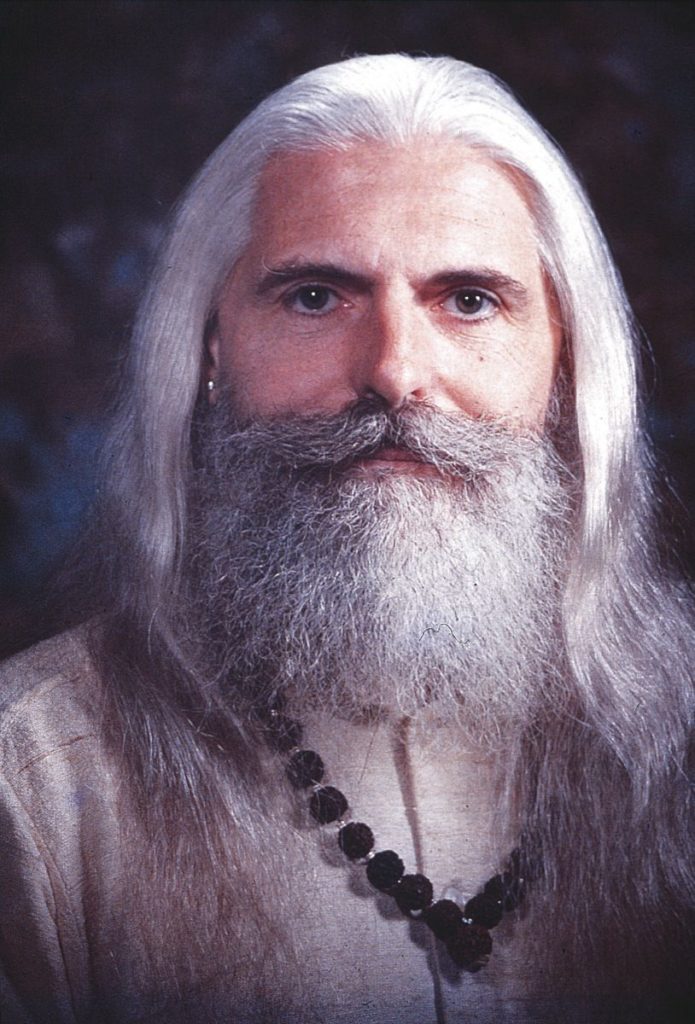
Miracles
Kauai Calls
The staff was so exhausted by the journey around the world that Master delayed their return to San Francisco and flew them to Kauai, where he had held the Ashram Kauai retreat in late 1968. They checked into a hotel at Poipu for much-needed rest. But Master seldom did well at that, and he immediately undertook a project to explore buying the idyllic Tropical Inn they had fallen in love with.
When Master asked a monk to inquire about such a purchase, the response came back, ‘But, it’s not even for sale.’ ‘Never mind that,’ Master consoled, ‘just go there and ask.’ The monk dutifully drove the 45 minutes to the place and, on his return, reported, ‘The owner said it’s not on the market.’ ‘I see. Now go back and ask him, just theoretically, how much he would sell it for if it were ever to go on the market.’
Back at the Tropical Inn, the monk dutifully spoke with the owner, retired Col. Albert Roesch, asking for a what-if price. ‘As my manager told you twice, it’s not for sale, young man.’ ‘Yes, I know. But if it were…,’ the monk sheepishly offered. Seeing there would be no respite until a number was forthcoming, Col. Roesch grumbled in a slightly threatening voice, ‘If it were to be sold, and I’m not saying it ever would, we would want no less than $300,000.’ Back at Poipu, Master heard the number and decreed, ‘Go back and tell him we can’t afford that much, but we can offer him $165,000 right away. No more. Tell him that.’ ‘But…’ ‘Trust me. Just go and make the offer.’ An hour later, the monk stood before the man and made the counteroffer with great hesitation. ‘Hmmm! Let me talk with my wife,’ came the unexpected retort.
The offer, amazingly, was accepted, and Master moved to the new property on February 5, 1970, spending the first night alone on the property to take psychic control before inviting the monks to join him the next day.
America’s First Hindu Monastery
In the early hours of February 15, 1975, lying on a tatami mat in his Ryokan room, Master had one of those profound periods of sleep that is neither awake nor full of dreams. In that clear space above physical consciousness, the 48-year-old Satguru experienced a threefold vision: the spiritual birth of the great Shiva citadel called Iraivan Temple and its surrounding San Marga Sanctuary.
‘I saw Lord Shiva walking in the meadow near the Wailua River. His face was looking into mine. Then He was seated upon a great stone. I was sitting on His left side. This was the vision. It became more vivid as the years passed. Upon reentering Earthly consciousness, I felt confident that the great stone was somewhere on our monastery land and set about to find it.
Guided from within by my Satguru, I hired a bulldozer and instructed the driver to follow me as I walked to the north edge of the property, a tangle of buffalo grass and wild guava. I hacked my way through the jungle southward as the bulldozer cut a path behind me. After almost half a mile, I sat down to rest near a small tree. Though there was no wind, suddenly, the tree’s leaves shimmered as if in the excitement of communication. I said to the tree, ‘What is your message?’ In reply, my attention was directed to a spot just to the right of where I was sitting.
When I pulled back the tall grass, there was a large rock—the self-created Lingam on which Lord Shiva had sat. A stunningly potent vibration was felt. The bulldozer’s trail now led precisely to the sacred stone, surrounded by five smaller boulders. San Marga, the ‘straight or pure path’ to God, had been created. An inner voice proclaimed, ‘This is the place where the world will come to pray.’ San Marga symbolises each soul’s journey to liberation through union with God.’
Timeless Legacy
In the spring of 1987, Gurudeva’s vision for Iraivan Temple evolved from a mystical revelation to a real-world plan. Working with sacred spaces architects in South India, he was defining its physical form, establishing the principles of its creation, and considering the style of the massive stone edifices built during South India’s Chola Dynasty a millennium ago. The big question was still pending: What form of Shiva would inhabit the inner sanctum? It was a meditation that continued for months, for he knew the relevance of this decision. It would define the temple more than any external style. It would be its life and essence, the holiest and most powerful force around which all else would circle.
A Clear Crystal Vision
One day, in an early-morning vision in his private quarters, Gurudeva saw the future, as he would later say. He often said, if you want to know what you should do, do this: In your mind, travel into the future, and from there look back and witness what happened. The present-day decision will be obvious.
In this vision of the yet-to-be, Gurudeva saw a giant crystal Shivalingam shining brightly in the sanctum of Iraivan Temple, radiating out to the world. It was a titan among crystals. It seemed in this first seeing to be impossibly large, unbelievable, and beyond reality. Perhaps, he thought, it is merely the spiritual form of the Shivalingam and not the physical one.
Downstairs a few hours later, he shared this vision with the monks, letting them know he had his answer as to which form of Shiva that Iraivan Temple would embody. It would be a crystal Lingam, known in Sanskrit as sphatika Shivalingam. In the ancient texts, a Lingam, which is the aniconic form of the Creator-Preserver-Destroyer of the universe, is the highest of worshipful icons. It represents That which is beyond representation, beyond form and even imagination. It is the All in all, the Self beyond time, form, space, and cause.
The Agamas say one can worship this Great God Shiva in the form of a Lingam made of mud or sand, of cow dung or wood, of bronze or black granite stone. But the purest and most sought-after form is the quartz crystal, a natural stone not carved by man but made by nature, gathered molecule by molecule over hundreds, thousands or millions of years, grown as a living body grows, but infinitely more slowly. Such a creation of nature is itself a miracle worthy of worship.
The monks were delighted to hear of their Guru’s revelation and imagined the meanings behind it. Kadavul Temple already housed God Shiva as Nataraja, the divine dancer who creates and inhabits every atom of the cosmos. Iraivan Temple would host Shiva as the transcendent beyond, immanent and transcendent, form and formless. It was perfect. But the monks were not at all prepared for what would happen next.
Gurudeva paid a visit the next day to the Crystal Journey shop at Kilohana on Kauai. He was there looking at the wares, asking the proprietor about crystals, looking for a large one he had visualised. She did not have such a crystal but eagerly shared her similar vision of a giant crystal.
Some weeks later, she called requesting to meet with Gurudeva, arriving at the monastery mid-morning. She was a mythical character, a child of the 70s, a cherubic, intelligent lady about 40 years old. In her long dress, looking a bit Roma, her round cheeks pink with the pleasure of her visit, she shared that she had an important message for him. She was taken to Gurudeva’s office, where he listened to her tale. ‘Gurudeva, I had a dream last night. In my dream, I saw, even more clearly than before, a giant crystal. Very tall and perfectly formed, just like the one you described. Not only that, I saw where it is. If you allow me, I want to go there. I want to find the crystal and bring it to you. Will you buy me a ticket?’
Never in his life had Gurudeva bought a ticket for a near-stranger on a dream-induced mission. But this was different. Gurudeva then told the visitor of his own dream that same morning, of how he had seen the giant crystal, too, but never imagined someone else might have the same vision at nearly the same time. He took it as a sign and did the unthinkable. He bought her a round-trip ticket to Arkansas, the Natural State.
Soon she was on a crystal quest. Along with Brazil, Arkansas is the world’s most abundant crystal source, and there were dozens of mines to be tracked down at the end of long, unpaved roads. Having never visited Arkansas, she took the logical course and began calling on the various mines in the area.
Ultimately she found the crystal at the mines of one James Coleman, a hard-scrabble man dressed in denim with a scrappy beard and calloused hands, whose father and grandfather had mined crystals and who knew the business like no other.
Striding to his Jeep, the taciturn miner motioned to her to get in. Off the two drove, about a mile on a pitted coral path some called a road that ended at an old wooden warehouse. Getting down, Coleman walked through the double doors and headed to the back of the open space, stopping at a pallet in a dark corner. On it was a musty mattress, worn and worthless, rolled in a circle, and tied with a hemp rope.
Coleman cut the rope with a pocket knife without so much as a word and threw open the mattress. There lay the massive, milky white quartz crystal. It was a marvel to behold, a perfect thing that could be an artifact in a museum of art or a masterpiece in the foyer of a billionaire’s mansion. But it was here, not far from nowhere.
His customary reticence overcome by the urgent need to relate his story, Coleman turned to the woman, who stood speechless, with happy tears washing down her cheeks.
‘In 1975 my brother and I were digging for crystals. Below these hills, there are honeycombs of caves where our rocks are harvested. We were 65 feet under that day when we found our way into a new cave. It was nothing unusual about it at first; it was twenty feet across and five feet high, all dark and dank. But then our light fell on this crystal. It had fallen and lay on its side, broken away from the cave floor. Around it on three sides was a colony of smaller crystals, ten or so, all still intact and growing. This one had stopped growing, of course. As you can see, it has six sides and is perfectly pointed, and its surface feels like cool ice, day and night. We went up to get the mattress and wrapped the crystal in it, dragging it inch by inch to the surface. It took us all day.
It was, to both of us, a fantastic discovery. Though our family has been mining crystals for three generations, no one ever heard of such a gem. My brother and I knew it was one of a kind, and we both sensed it had a destiny, though we didn’t know what that might be. Something extraordinary. We kept it in the mattress and brought it here, out of sight, vowing not to tell a soul about it. But somehow, you saw it. How else would you know? We figured that one day we would learn what the crystal was meant for. I think it was meant to go with you to Hawaii and be with that holy man who saw it. The crystal has been waiting, and I’m glad you came to get it.’
The crystal seeker was exultant. She called Gurudeva, who asked for photos to be sent. When he saw them, he said, ‘Yes, that’s it!’ She arranged for the purchase and packing of the crystal, then flew home. The 700-pound, 39-inch-tall sphatika Shivalingam arrived at the monastery on August 14 and was formally installed in front of Lord Kadavul Nataraja two days later, awaiting the day Iraivan Temple would be completed. Gurudeva’s morning vision had manifested magically.
Crystal Significance
One afternoon years later, a deva with whom Gurudeva often communicated signaled that he was present and asked if there were any questions. The monk with him asked about the significance of the enormous crystal. With the same ease that ordinary people listen to a friend speak, Gurudeva clairaudiently heard the inner-plane deva’s answer and dictated it to his amanuensis in two- and three-word volleys:
‘Now, the large crystal we have is very special, having been especially prepared for its mission as a relay station for peace on Earth, harmony, contentment, healing and patience, freedom and goodwill and close cooperation among the life forms and humans beings on this planet. It is at this very moment relaying trillions of messages through every crystal on this planet, energising and educating even the smallest insect.’
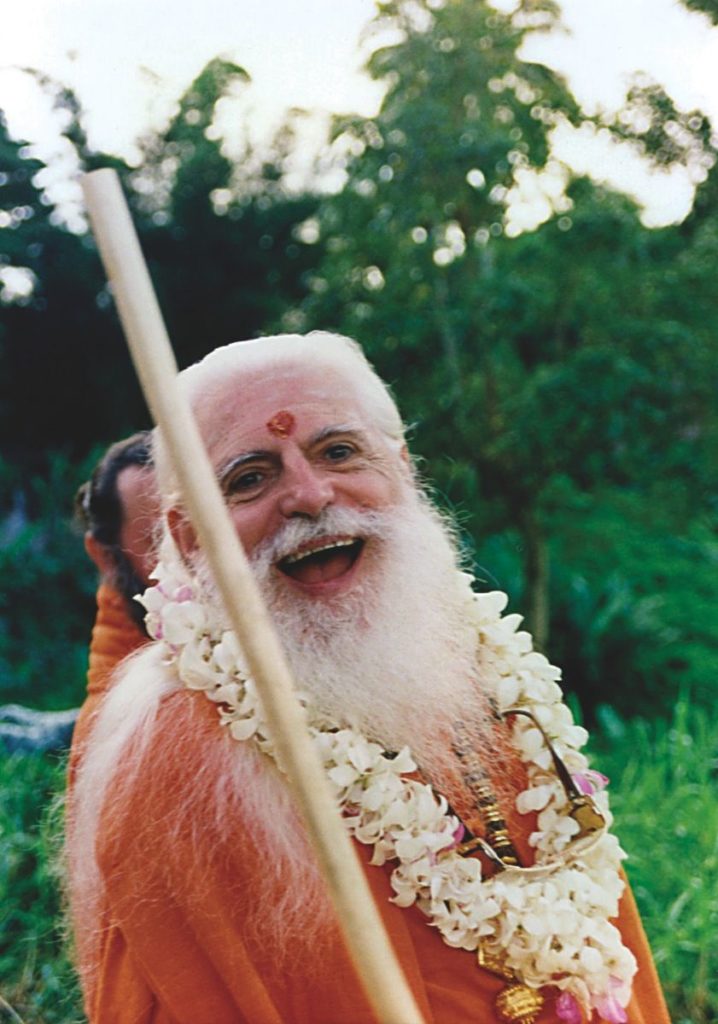
Contemporary Masters
Satguru Bodhinatha Veylanswami
The spiritual leader of Kauai Aadheenam is Satguru Bodhinatha Veylanswami. He has been the monastery’s head since the founder, Satguru Shivaya Subramuniyaswami, attained mahasamadhi, his great departure, in 2001. Subramuniyaswami, known affectionately as Gurudeva, designated Bodhinatha, a disciple for 37 years, as his successor.
Most of the year, he is on the island of Kauai, where he oversees the varied publications of Himalayan Academy and serves as publisher of the international magazine Hinduism Today. At the 382-acre monastery temple complex, he trains the younger monks in their service duties and spiritual practices and guides the lives of hundreds of families around the globe. Following in Gurudeva’s footsteps, he works informally with Kauai leaders to perpetuate the island’s aloha spirit of love and friendliness and help the community achieve greater sustainability.
Bodhinatha is immersed in a series of educational projects and international seminars that focus on bringing religious instruction to Hindu youth and pamphlets and books that present Gurudeva’s teachings in a thoughtful, step-by-step style. A recent project produced the first two books of the series ‘Hindu Children’s Modern Stories’. Volume One, Ten Tales About Self-Control, and Volume Two, Ten Tales About Religious Life, are based on the yamas and niyamas, Hinduism’s ethical restraints, and religious observances.
Bodhinatha travels intensely, teaching Hinduism and consecrating major Hindu temples around the world. He has personally blessed the openings of temples in North America, Australia, and India. Communities across the United States, Canada, the Caribbean, South Asia, and elsewhere have brought him to speak to their devotees. Every few years, he conducts Innersearch Travel-Study Programs, taking pilgrims to India, Australia, New Zealand, Malaysia, Cambodia, and, most recently, to the Hindu-majority island of Mauritius in 2015.
In 2011, the Shivacharyas of India honoured him for overseeing a three-year project that digitised over a million inscribed palm leaves to preserve and share with the world ten thousand deteriorating manuscripts, including Shaiva Agamas and other important scriptures. Additionally, he guides the financial and administrative staff of four major nonprofit organisations, including the eighteen-million-dollar Hindu Heritage Endowment. He was the principal architect under Gurudeva’s guidance.
Holy Sites and Pilgrimages
Source: www.himalayanacademy.com
Satguru Shivaya, Subramuniyaswami (1927-2001), founder of the temple, stands with the extinct volcanic mountain, Waialeale, in the background.
Located in the heart of a traditional Hindu monastery complex reminiscent of ancient mathas and aadheenams of India, Iraivan is more than a temple; it is a pilgrimage destination, a place of sadhana and spiritual rejuvenation. Iraivan Temple is a living edifice that brings ancient tradition into the 21st century, a stable anchor sustaining and strengthening Hindu dharma for our children, their children, and generations to come. In 2001, Gurudeva said: ‘When you begin the pilgrimage to Iraivan Temple, you drop off and dissolve the karmas of the past. Then, because of the direction the temple is facing, the temple gives a new start, a new impetus for a wonderful future. It is a boon-giving temple, a gift-giving temple, a life-giving temple, a wish-fulfilling temple.’

An aerial photo of Iraivan amid the newly developed sacred gardens.

Four silpis (sculptors) work patiently on the two massive yalli handrails that will frame the entry.
Plan Your Visit
VISITING HOURS
The front area of the monastery up to the private temple entry wall and gate leading to Kadavul Hindu Temple is open from 9:00 a.m. – noon. All are welcome to meditate under the beautiful banyan tree, explore the large information panels in the Banyan Mandapam, which speak about our monastery and the Hindu religion, and browse through the many publications and Hindu religious supplies in our Mini-Mela visitor center. Always plan to come in the morning.
Unlike most Hindu temples, which are public, Kadavul Hindu Temple and the monastery grounds surrounding it are private due to their presence within a traditional Shaivite aadheenam or monastery/temple complex. To protect the sanctity of the temple ceremony, only those visitors who wish to worship at the traditional 9:00 a.m. temple ceremony (Shiva puja) are welcome to enter the inner gate leading to the temple before 10:45 a.m. Visitors who do not wish to participate in the worship are welcome to enter this area from 10:45 a.m. – noon.
For information about our regular public tours, please continue reading below.
PROTOCOL
You are welcome to attend the traditional Hindu worship ceremony (called puja) at 9 a.m. Inside the temple, guests should ideally sit cross-legged, but never with legs stretched out towards the Deity. No video or photography is allowed of the inside of the temple.
Note: Only those wishing to worship or meditate should enter Kadavul Temple.
A self-guided tour is available for the front area. Download the map or pick it up along with an accompanying booklet at the entrance. The tour will give you a basic introduction to the monastery and its areas of service. Please come early. The property closes at noon.
If you are a Hindu planning to visit on one morning or for a longer pilgrimage, please read our additional guidelines.
DRESS CODE
Guests are encouraged to dress in traditional Hindu clothing when visiting. Alternatively, modest clothing is permitted. No shorts, short dresses, tight-fitting yoga pants, t-shirts, or tank tops. Polo shirts and long shorts that cover the knees are okay.
SOME OTHER IMPORTANT GUIDELINES
- Video and photography of the inside of Kadavul Temple is not permitted. All other areas may be photographed.
- We ask visitors to bring an umbrella as it rains often.
- It is always prudent, even in paradise, not to leave valuables in your car.
- We do not provide meals at the monastery. You are welcome to use our local Kauai Dining Guide to help plan your meals while on pilgrimage.
- For sizeable groups planning a visit, please email here to coordinate your visit.
- For Hindus seeking an audience with Satguru Bodhinatha Veylanswami, please click here for more information.
Public Guided Tours

Approximately once a week, a guided tour begins at 9 a.m. in the gazebo at the monastery entrance, 107 Kaholalele Road. It lasts about two hours. The tour is free; however, love offerings are welcomed as donations from visitors allow us to continue building the new Iraivan Temple and beautifying this sanctuary. Parking is very limited; therefore, reservations are required. Please call toll-free 1-888-735-1619 to find out upcoming tour dates and reserve your parking space. (Please note, there are no public guided tours in the month of December, or in the first two weeks of April and August.) Reservations are not required if you arrive by taxi, and the taxi does not stay. Highlights of the walking tour include:
- Introduction to the monastery and Hinduism
- The spiritual sanctuary with its botanical gardens, waterways, and ponds
- View the under-construction granite Iraivan Temple–a noble icon of Hinduism’s beauty and greatness
- The awesome, monolithic, 20,000-pound, 12-foot-tall black granite statue of God Shiva as Dakshinamurthi
- Kadavul Hindu Temple with its central sanctum housing an exquisite, 6-foot-tall bronze statue of God Shiva as Nataraja, Lord of the Dance. The temple also houses Iraivan Temple’s future 700-pound, 39-inch-tall quartz crystal Shivalingam deity.
- Much of the walking tour is on uneven/slippery ground, so please wear appropriate, strong grip footwear. High heels are not safe. Also, if there are heavy rains, the guided tour may be confined to our front area.

Capstone of Iraivan Temple at Kauai’s Hindu Monastery
Bibliography
The Master Course is Gurudeva’s most monumental work, a comprehensive treatise on every aspect of Shaivism in three books and more than 3,000 pages, composed in what he called ‘talkanese’ – a flowing version of written English that resembles the spoken language and evokes ancient Hindu oral traditions.
His Master Course includes three books :
– Dancing with Shiva
– Living with Shiva
– Merging with Shiva
Some of his other books:
- Yoga’s Forgotten Foundation
- Loving Ganesha
- How to Become a Hindu: A Guide for Seekers and Born Hindus
- Tirukkural: The American English and Modern Tamil Translations of an Ethical Masterpiece
- Holy Orders of Sannyas: A Shaiva Swami’s Diksha and Lifetime Vows of Renunciation
- Weaver’s Wisdom: Ancient Precepts for a Perfect Life
- Pancha Ganapati: An alternative for Christmas
Subjects include deep metaphysical insights into God’s nature, soul, world, mind, emotions, ultimate realisations, chakras, and life’s purpose on Earth. Simple but effective practices are taught: how to remold human nature and karmas, calm the mind, develop self-esteem, begin to meditate, clear up the past and create a bright future. At the same time, the reader is guided in establishing a regular devotional and yogic practice whereby the gains of his inner life and realisations are stabilised and used in practical ways. Gurudeva’s Master Course lessons for children are taught in many schools, preserving the teachings of Shaivism among thousands of youths.
Honours and Awards

- 2000: Gurudeva receiving the U Thant Peace Award at the United Nations in New York
- 1986 – New Delhi’s Parliament of the World’s Religions named Shivaya Subramuniyaswami one of five modern-day Jagadacharyas, means world teachers, for his international efforts in promoting Hinduism.
- 1988 – Oxford, England: Hindu representative at the Global Forum of Spiritual and Parliamentary Leaders for Human Survival. Shivaya Subramuniyaswami joined hundreds of religious, political, and scientific leaders from all countries to discuss privately, for the first time, the future of human life on this planet.
- 1988 – Oxford: he represented Hinduism at the Global Forum of Spiritual and Parliamentary Leaders.
- 1990 – Moscow : he again represented Hinduism at the Global Forum of Spiritual and Parliamentary Leaders
- 1992 – Rio de Janeiro : he again represented Hinduism at the Global Forum of Spiritual and Parliamentary Leaders
- 1993 – Chicago: at the centenary Parliament of the World’s Religions, Shivaya Subramuniyaswami was elected one of three presidents, along with Swami Chidananda Saraswati of the Rishikesh-based Divine Life Society and Kerala’s Mata Amritanandamayi, to represent Hinduism at the Presidents’ Assembly, a core group of 25 men and women voicing the needs of world faiths.
- 1995 – New Delhi’s Parliament of the World’s Religions bestowed on Shivaya Subramuniyaswami the title Dharmachakra for his remarkable publications.
- 1997 – Shivaya Subramuniyaswami responded to the US President’s call for religious opinions on the ethics of cloning from the Hindu point of view.
- 1997 – Shivaya Subramuniyaswami spearheaded the 125th anniversary of Satguru Yogaswami and his golden icon’s diaspora pilgrimage through many of the over 75 Sri Lanka temples and societies around the globe.
- 2000 – On August 25, he received the U Thant Peace Award (an award created by Sri Chinmoy) at the United Nations in New York. Prior recipients of this award were the Dalai Lama, Nelson Mandela, Mikhail Gorbachev, Pope John Paul II and Mother Teresa. He addressed 1,200 spiritual leaders gathered for the UN Millennium Peace Summit, with the message, ‘For peace in the world, stop the war in the home.’
External Links
- Gurudeva’s Master Course online—updated daily: www.gurudeva.org/lesson.shtml
- TAKA archives: www.gurudeva.org/archives/
- Short biography of Gurudeva: www.gurudeva.org/gurudeva/
- Cybertalks: www.gurudeva.dynip.com/~htoday/talks/
- Kauai’s Hindu Monastery: www.saivasiddhanta.com/hawaii/
- Iraivan Temple: www.saivasiddhanta.com/hawaii/iraivan/
- Academy study: www.himalayanacademy.com/academy/
- Gurudeva’s books: store.himalayanacademy.com
- Hindu basics: www.himalayanacademy.com/basics/
- Hindu Heritage Endowment: www.hheonline.org
- Thank You, Gurudeva Fund: www.hheonline.org/funds/thankyou_gurudeva.html
- Accolades: www.himalayanacademy.com/site_comments/

